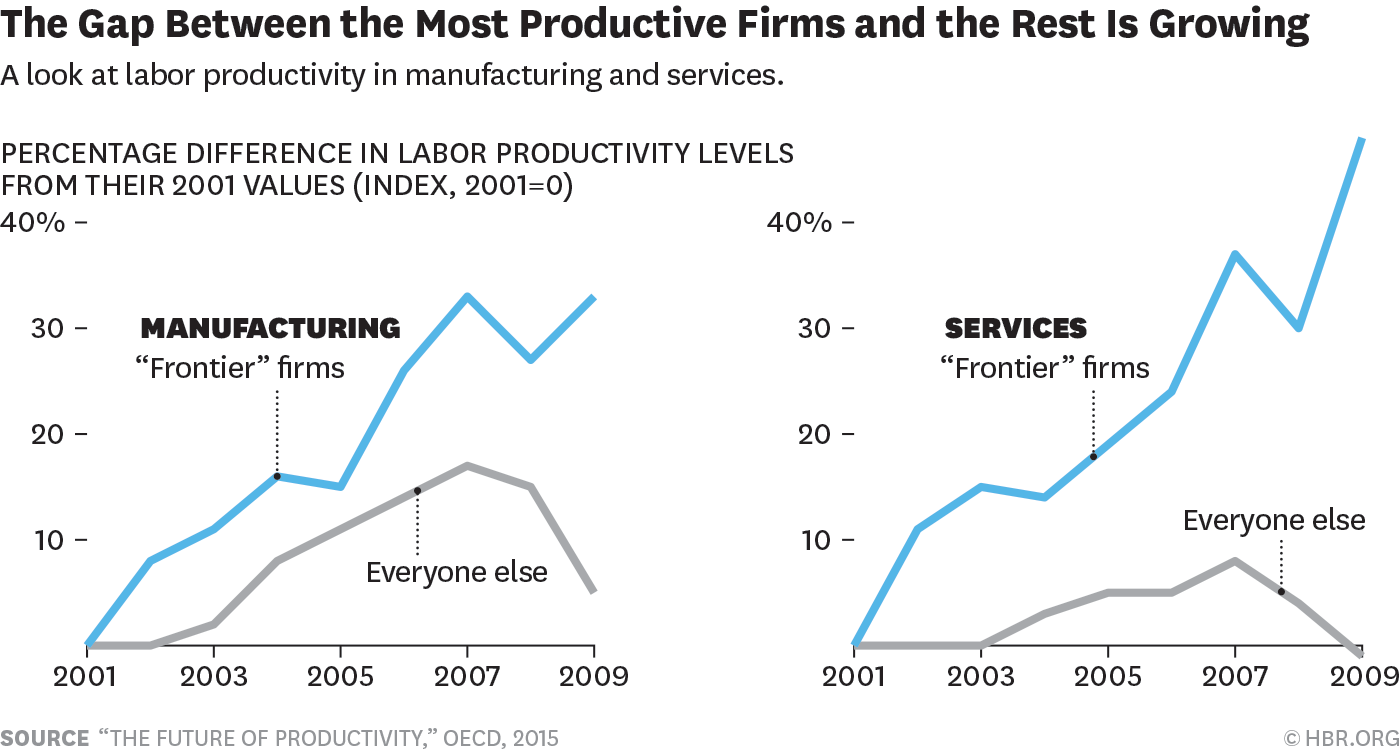How fast do you learn? How fast does your team learn? What about your organization’s speed of learning? Is it faster than your competitors?
Jack Welch famously said “if the rate of change outside your organization is faster than the rate of change inside you’re already dead”. But I would argue that this statement needs revision.
If the rate of learning outside your organization is faster than the rate of learning inside your organization you’re already dead.
The Productivity Gap
OECD data from 2015 (reproduced in the Harvard Business Review) shows the difference between productivity levels of high performing organizations. In the services industry, this gap is almost double and growing exponentially!

What enables these “frontier firms” to tear ahead is an ability to quickly discover better solutions to address customer needs, product gaps or process improvements? Put simply, they make it economical to run multiple small experiments, to work in small batches and out-learn their competition.
The more frequent, faster and cheaper your organization can run experiments, the more quickly it will learn.
In his 2011 talk “Velocity Culture, The Unmet Challenge in Ops”, Jon Jenkins, former Amazon engineering lead for eight years, shared that Amazon was performing 1,079 software deployments an hour—one every 11.6 seconds. That’s 1,079 opportunities per hour to learn; what works, what does not, safely. This capability allows Amazon to quickly and accurately gather new information to adapt their approach based on the results of testing their hypotheses. Once every 11.6 seconds, and that was in 2011! How fast do you think they are iterating today?
Why Leading Companies Invest in Platforms To Experiment
If your organization is only deploying software once a month, you’re only creating 12 opportunities each year to learn in the market. And because deployments are so difficult to perform and loaded so many features it is impossible to link effort to outcome (signal to noise). If numbers go up, everyone claims the victory. If numbers go down, no one claims defeat. Similarly discovering issues is a myriad of time and effort.
Amazon posted their latest profit statement, and effectively pronounced Jeff Bezos as the third richest person in the world. The Amazon Web Services business now accounts for 28% of Amazon’s profit. Not only are they orders of magnitude ahead of Google and Microsoft in the cloud race, they’re making more sophisticated and complex mistakes too!

How To Increase Your Rate of Learning
The good news is that you do have options even if you don’t have a capability of Continuous Delivery in your organization. You can start improve your rate of learning straight away by getting out of your seat and talking to the customers and users of your products, services and processes. New insight is only a few quick questions away.
Secondly, ask your team what their rate of learning is. Nine out of ten? Six out of ten? Lower?
Could you set an aspirational target condition for the rate of learning for the team? Ask yourselves how you could to achieve it? What would be the first step? Introducing early customer testing with prototypes? Implementing Continuous Delivery to deploy software more frequently and faster? Engaging business stakeholders more regularly to showcase your work for feedback and improvement throughout development? It’s your team – develop your own experiments and start learning today.
Finally, make the economic argument to your CFO, CEO or Board of Directors as to why working in smaller batches is a quicker, less risky and more effective way to deliver. Show how it will create new knowledge, improve decision-making and lead to better overall investments. If they ask for more evidence point them to the economics, growth speeds, and mathematics (and because Donald G. Reinertsen said so).
When We Experiment, We Learn
The goal of business experimentation is to make new discoveries quickly, cheaply and to improve decision-making. By increasing the rate of testing we increase the knowledge we create. We can then leverage that knowledge to capitalise on positive signals or change course to mitigate poor investments.
Knowledge is the currency of the information-age. In the race to thrive or survive, whoever can create knowledge the quickest, most cheaply and to the best fidelity will win.
So make your personal, team and organization’s rate of learning the one metric to rule them all.

